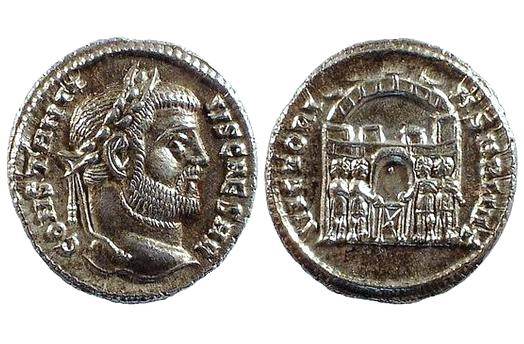
about ancient nomos
Ancient Nomos Art is a museum of galleries exhibiting ancient coins and ancient mint maps. The coin gallery displays the diverse art and history of hand-crafted ancient Greek, Roman, Byzantine, Persian and Medieval coinage. The ancient mints mapping gallery features Greek, Roman, Byzantine, Asia Minor and Medieval mint city regions and territories. Visitor's are welcome to explore, study and enjoy Ancient Nomos Art.

Imperial, Roman – 295 AD
Constantius I
From Ancient Galleries

Obverse: Laureate head of Constantius I as "Caesar" facing right with full beard.
Reverse: Four Roman tetrarchy leaders sacrificing over altar before city gates.
LEGEND
Obv. CONSTANTI – VS CAESAR, Laureate bust of constantius I Chlorus facing right as Caesar. Rev. VICTORI – A SARMAT, Four tetrarch emperors sacrificing over tripod before the city/camp-gate archway with eight turreted stone enclosure walls.
Constantius I “Chlorus” or Flavius Valerius Constantius, was born in 250 AD of peasant family origins in the Danubian region of Dacia. He served in the Roman army as a young man and achieved distinction as governor of Damiatia and later as praetorian prefect under the Maximianus command. After Maximianus was declared Emperor of the western empire by Diocletian, he assigned Constantius as subordinate ruler of Western Europe and was given the title senior Caesar on 1 March 293 AD. Galerius, junior Caesar of Eastern Europe, became the fourth tetrarchy ruler. As the new co-emperor assigned to rule the provinces of Galliae and Roman Britanniae, Constantius spent much of his early imperial career fighting off the usurper Carausius along the Rhine and at the famous battle of Gesoriacum. A decade later he fought the invading Picts on the British Isles, but this time he was aided by the assistance of his eldest son, Constantine the Great. The coin above was issued during his first dozen years as co-emperor with Maximianus, remaining nearly identical to other Tetrarchy coinage, except for the specific legend naming Constantius as Caesar. Only the Latin title of “Caesar,” inscribed to the right of his bust, informs us that this is a Constantius was serving under Maximianus. The coins reverse depicts the four Tetrarch rulers standing before a camp (or city) gate. As the four rulers stand guard, symbolically protecting entry into the empire or camp, they are also seen conducting a ritual military sacrifice over a sacred Roman tripod. The background scene depicts a protective four-turreted stone entry enclosure elevation, juxtaposed with a semi-circular plan view of the stone enclosure walls above. The reverse Latin legend, VICTORI A SARMAT, translates to mean “Victory to the Sarmatian” territory. Constantius died 25 July 306 AD in York and was considered by many to have become the first Roman emperor in his later years to worship a Christian prayer before a Britanniae battle.
DOCUMENTATION
Value: Argenteus. Metal: AR Silver. Weight: 3.01 grams. Mint: Siscia. Date: 294-295 AD.
Attribution: Roman Imperial Coinage, VI 35a; Jelocnik 11; RSC 289b; Sisak Hoard, 10a.
Legend, Documentation and Attribution
